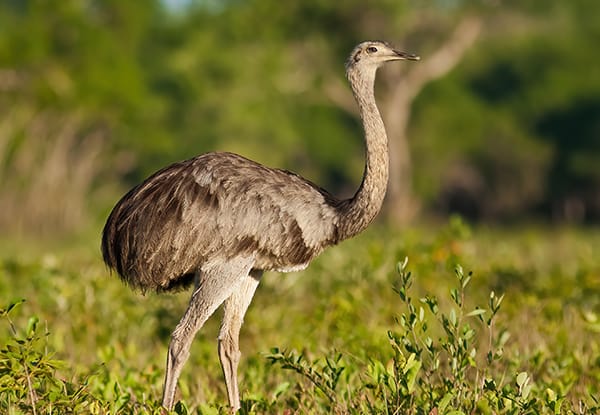Greater Rhea
Greater rheas are the largest living birds native to the Americas.
Day of Creation: five
Biblical Kind: rhea (includes the greater rhea and lesser rhea)
Status: near threatened
Length: 4.5–5.5 feet (1.4–1.7 meters); up to 6 feet (1.8 meters) has been recorded
Weight: 40–60 pounds (18.1–27.2 kilograms); up to 88 pounds (39.9 kilograms) has been recorded
Habitat: grasslands, scrubs, open woodlands, and wetlands of eastern South America
Lifespan: 10–15 years
Diet: leaves, seeds, thistles, fruits, roots, invertebrates, small vertebrates, feces
Family Life: during the nonbreeding season, they live in flocks of 10–100 birds; during the breeding season, mature males become solitary, mature females form flocks of 2–15 birds, and yearlings form large flocks
Reproduction: females lay 5–10 eggs per nest, which hatch after a 4–7-week incubation
Fun Facts
Rheas are named after the Greek Titan, Rhea, whose name comes from the Ancient Greek word for “ground.” This name likely refers to their flightlessness.
Both rhea species average the same weight, so the primary difference between greater rheas and lesser rheas is that greaters tend to have longer necks and legs, while lessers are more compact. They have been known to hybridize.
Rheas are flightless but use their long wings while running 40 mph (64.4 km/h) to maintain stability and speed. They often run in zigzags, and the wings balance them during tight turns. They also use their wings for courtship displays.
Males and females breed with multiple partners, but males are responsible for incubating eggs and raising chicks, a six- or seven-month process. Males will raise offspring from multiple females, meaning they may care for over 60 chicks at once.
There is a small population of greater rheas in northern Germany that is descended from one male and five females that escaped from a farm in 2000. The most recent survey numbers the birds at 600, and they are starting to affect local farmers. Although they have previously been protected, the German government now allows the hunting of the birds and their eggs to control the population.


